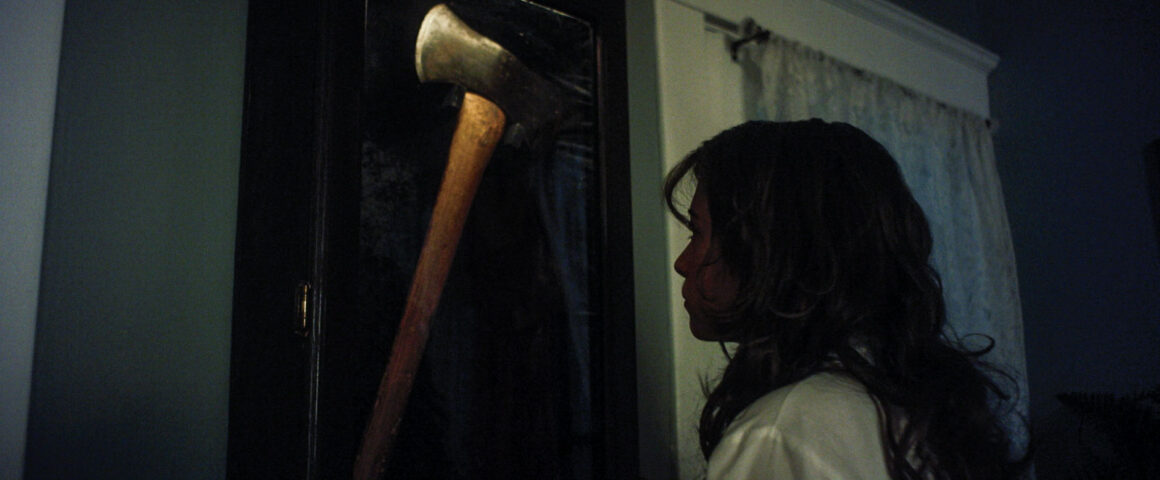The case of Lizzie Borden is popular and famous, to the extent of having effectively entered folklore. Taking place in Fall River, Massachusetts in 1892, the murders of Abby and Andrew Borden and the trial of Andrew’s daughter Lizzie the following year that ended in her acquittal, has been the subject of books, theatrical productions, folk rhymes and indeed movies. The Inhabitant joins this limited sub-genre, but rather than depicting the events of the murders themselves, Jerren Lauder’s film explores the legacy of such a dark history. The opening supertext of the film provides the context of the case, and introduces the (fictional) idea that the descendants of the Borden family have been plagued by the “family curse.” Thus, The Inhabitant draws on recorded history but also distinguishes itself from that history, creating a haunting and at times gruesome modern-day tale out of the documented details.
Odessa A’zion (“Hellraiser”) plays Tara, a teenager in contemporary Fall River, and a descendant of the Borden family. Tara faces typical growing pains — her boyfriend Carl (Michael Cooper Jr., “On the Come Up”) is going away for college; she and her younger brother Caleb (Jackson Dean Vincent, “The Secrets We Keep”) bicker over their infant brother Jack; parents Emily (Leslie Bibb, “Running with the Devil”) and Ben (Dermot Mulroney, “The Mountain Between Us”) are having difficulties, leading Caleb and Tara to wonder which parent they will end up with. There is also the matter of Tara’s aunt Diane (Mary Buss, “Lord Finn”), locked away in a psychiatric hospital because she murdered her infant child, a crime linked to the infamous ancestor.
Perhaps more pressing is that there are murders taking place in Tara’s neighborhood. The police initially treat them as missing persons, but the audience are treated to scenes of murder. These sequences are suspenseful as the victims sense someone is nearby, sometimes in isolated surroundings like a pre-dawn jog through the town, or during a walk home through woods. But other murders take place within the home, making it clear that nowhere and no one is safe. The murders are shocking and brutal, featuring ample blood spatter but also injury detail. This makes the film wince-inducing, especially when limbs are split, accompanied by screams of agony. No quick and simple kills à la Michael Myers here — while the killer’s face remains out of shot, the ax and its impact are there for all to see.
Who is responsible for these murders? Each victim is linked to Tara. Could someone be striking on her behalf? Is Tara losing her grip on reality? Or is there something supernatural at play? This obscured face or silhouette of the killer sets up a whodunnit, perhaps akin to “Scream,” and The Inhabitant does borrow from the slasher genre with its stalk and slay set pieces, though the wider context is more reminiscent of psychological/supernatural horrors like “Secret Window,” “Rosemary’s Baby” and “Gothika,” where the source of the horror is ambiguous. Lauder’s direction as well as Kevin Bachar’s script maintain this ambiguity throughout the film. At times we are drawn towards one suspect, but as more details are revealed, we are treated to other plausible answers. Dream sequences as well as a seance are thoroughly eerie, with quick cuts creating a distorted perception, closely tied to Tara and ensuring the viewer is as confused as the protagonist or indeed those around her.
Furthermore, the environment in which this takes place itself feels inhabited. Tara’s home is an extensive interweaving of rooms and corridors, a place of comfort but also tension and even menace. Tara’s relationship with her parents is as fractious as that between them, and her best friend Suzy (Lizze Broadway, “Ghosted”) is her closest confidant. It turns out, however, that there is more to Suzy than meets the eye. While her character is perhaps under-served, the attention paid to her allows the film to refer to various issues around identity and relationships. Sequences focused on Suzy are among the most tragic, not least because she is the one Tara can always go to, but Tara remains ignorant of much of Suzy’s pain.
Pleasingly, the film’s focus is maintained on the females, with the male characters — Carl, Ben, Caleb — kept on the periphery. Horror is well served when focused on women, because of the genre’s inherent concern with victimhood. The frequent victim position of women, such as Tara receiving unwanted male attention and the institutionalization of Diane, adds to the sense of women’s compromised subjectivity. The largely absent father suggests that Emily is neglected, and that Tara must force a space for herself, which is all the more difficult when her own mind is unreliable. Thus, one could read the murders as a violent eruption in the face of female suppression, just as much as a mental illness or a family curse, although the uncertainty that pervades the film allows for multiple readings.
This uncertainty is facilitated with a fluid visual style, including long panning takes as well as a delicate shifting of position within shot/reverse-shot patterns. During an early conversation between Tara and therapist Dr. Sanchez (Sabreena Iman, “The Line”), the camera pans behind one character’s head but instead of completing the motion in that position, we cut to a completion of the motion behind the other character’s head. Meanwhile, a jarring editing pattern continues throughout, as past and present, memory, dream and reality cut between each other. This style keeps the viewer off balance, as confused by what could be happening as Tara. This lack of clarity, combined with the visceral and indeed emotional violence, ensures that The Inhabitant is eerie, gripping and shocking, with an ambiguity between the psychological and supernatural as sharp as an axe blade.



